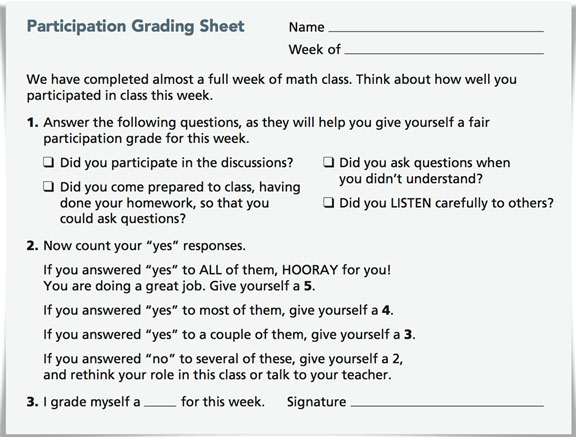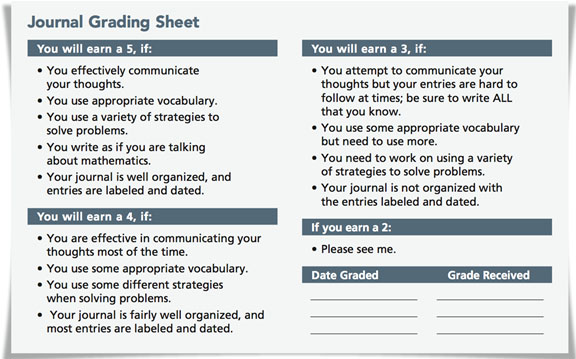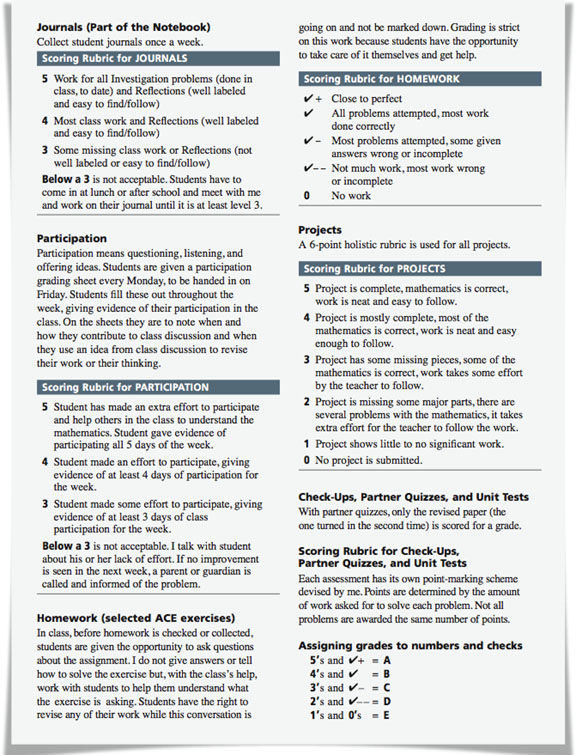Grading Examples from CMP Classrooms
The multidimensional assessment in CMP provides opportunities to collect broad and rich information about students’ knowledge. Teachers face the challenge of converting some of this information into a grade to communicate a level of achievement to both students and parents. The following assessment items offer teachers an opportunity to assign grades: ACE exercises, CheckUps, Partner Quizzes, Mathematical Reflections, Looking Back, Unit Tests, Projects, Notebooks, and Self-Assessments. The use of these assessments for grading and the value assigned to them vary from teacher to teacher. While most teachers view the Problems as the time to learn and practice mathematical concepts and skills, some teachers will occasionally assign a grade to a Problem. Some teachers also choose to grade class participation.
Two teachers’ grading schemes for their CMP mathematics classes follow. These are given as examples of possible grading schemes. Note that each of these teachers has made independent decisions about how best to use the assessment tools in CMP for grading purposes.
Example 1: Ms. Jones’s Grading System
Participation
I try to take several things into account when grading students in mathematics class. I work to build a learning community where everyone feels free to voice his or her thoughts so that we can make sense of the mathematics together. I try very hard to assess and grade only those things that we value in the classroom.
Because participating in discussions and activities is so important in helping the students make sense of the mathematics, this is one part of the students’ grades. They rate themselves at the end of each week on how well they participated throughout the week. Below is a sample of the grading sheet they fill out. The participation grade counts as 15% of their total mathematics grade.

Journal
I try to take several things into account when grading students in mathematics class. I work to build a learning community where everyone feels free to voice his or her thoughts so that we can make sense of the mathematics together. I try very hard to assess and grade only those things that we value in the classroom.

Homework
The curriculum is problem-centered. This means that the students will investigate mathematical ideas within the context of a realistic problem, as opposed to looking only at numbers. Students spend much of each class period working with a partner or in a small group trying to make sense of a problem. We then summarize the investigation with a whole class discussion. The ACE exercises assigned offer students an opportunity to practice those ideas alone and to think about them in more depth. Homework assignments are very important! They provide students the opportunity to assess their own understanding. They then can bring their insight and/or questions with them to class the next day. We usually start each class period going over the exercises that caused difficulty or that students just wanted to discuss. Keeping up with the homework (given about three or four times a week) helps students to stay on top of their learning. It also allows me to see what students are struggling with and making sense of Homework assignment grades count as 20% of their total grade.
Partner Quizzes
All of the quizzes from CMP are done with a partner. Because a lot of what we do in class is done with others, I want to assess students “putting their heads together,” as well. Again, I try to grade what I value, which is working together. Quiz grades count as 20% of their total grade.
Final Assessment
At the end of each unit an individual assessment is given. Sometimes it is a written test, sometimes a project, and sometimes a writing assignment. These serve as an opportunity for students to show what they, as individuals, have learned from the whole unit. Test and project grades count as 30% of their total grade, as they are a culmination of the whole unit.
Grading Summary
- Participation . . . . . . . . . . 15%
- Journals . . . . . . . . . . . . . . 15%
- Homework . . . . . . . . . . . . 20%
- Partner Quizzes . . . . . . . . 20%
- Tests and Projects . . . . . . 30%
Example 2: Mr. Smith’s Grading Scheme
